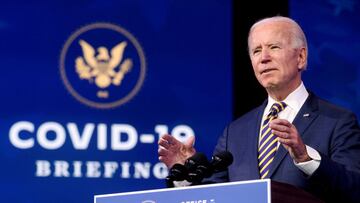What is the minimum wage that Biden has proposed and what do the experts think of it?
The American Rescue Plan would double the national minimum wage by 2025 but some worry that this could hit businesses already struggling with the pandemic.

In early January President Joe Biden officially announced his flagship economic policy, the American Rescue Plan, when he hopes will help the United States rebuild after the hugely damaging pandemic.
A White House briefing makes clear that “the current crisis is generating deeply inequitable outcomes for American families”. With this in mind much of Biden’s stimulus package is aimed at improving conditions for low income earners who are most at risk currently.
As well as the stimulus checks and additional unemployment benefits, Biden’s plan would put in place a gradual raising of the federal minimum wage to $15-per-hour by 2025. This would more than double the current figure, prompting some concerns about the economic impact on businesses.
Biden uses executive order to boost minimum wage for federal workers
Negotiations are still on-going between Democrats and the Republicans in an attempt to find bipartisan support for Biden’s stimulus bill, but the President has been able to impose some elements of his agenda more swiftly.
He signed a raft of executive orders during his first days in office; many simply reversed what he saw as the worst injustices of the Trump administration, but he also made a big change to the minimum wage for federal workers.
An order signed during his first week in office will ensure that all federal workers are moved toward $15-per-hour, with contractors working on behalf of the federal government to do the same.This is a sizeable increase on the $7.25 which was the previous minimum wage, which had not been altered since 2009 despite the cost of living going up sharply.
Minimum wage increase to be included in Biden’s American Rescue Plan
A package the size of Biden’s stimulus bill requires approval from Congress before it can be passed, so we are still awaiting exact details of the final bill and what it will mean for the national minimum wage. What is known is that the $15-per-hour minimum wage is a central part of Biden’s plan to empower the low- and middle-earners.
As mentioned this would be a huge increase on the $7.25 minimum wage currently in place, but there are signs that support is growing for such a measure. Before Christmas the state of Florida approved a ballot measure which will see the hourly minimum wage upped to $15 by 2026 at the latest. This, from a state which did not vote for Biden in the last election, has given the President confidence that it can be done nationally.
“People tell me that’s going to be hard to pass,” Biden told reporters after announcing the American Rescue Plan. “Florida just passed it. The rest of the country is ready to move as well.”
Nationally, around 40% of the US workforce currently work in an area where there is, or there are plans to implement, a minimum wage of at least $15-per-hour. Critics have previously suggested that such a rise could be disastrous for the economy but many experts now believe that is not the case.
Ben Zipper, economist at EPI, believes the additional spending power will actually boost the economy, saying: “This injection of wages will help stimulate the economy and spur greater business activity and job growth”.






